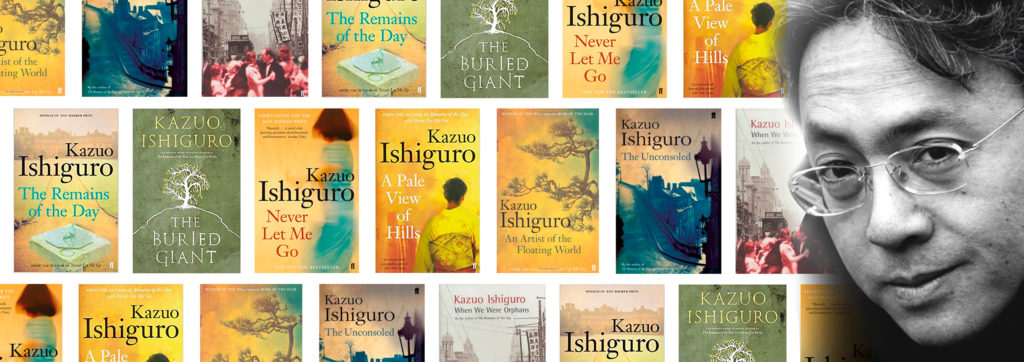Kazuo Ishiguro's Novels: A Study Of Remembrance And Imagination

Table of Contents
The Power of Remembrance in Ishiguro's Narrative Structure
Ishiguro masterfully employs unreliable narrators and fragmented memories to construct his narratives, forcing the reader to actively participate in piecing together the puzzle of the past. This technique significantly shapes our understanding of his characters and the events they recount. The narrative structure itself becomes a reflection of the unreliable nature of memory.
-
The Remains of the Day: Stevens, the steadfast butler, narrates his story through a veil of carefully constructed recollections, revealing only gradually the emotional depth hidden beneath his stoic exterior. His unreliable narration creates a sense of mystery, forcing the reader to question the validity of his memories and understand the impact of past trauma on his present self. The reader is left to grapple with the limitations of Stevens's self-awareness as his recollection unfolds.
-
Never Let Me Go: The fragmented memories of Kathy, Ruth, and Tommy contribute to the unsettling atmosphere and emotional weight of the novel. Their hazy recollections of childhood, coupled with the gradual revelation of their predetermined fates, create a chilling sense of unease. The fragmented nature of their memories mirrors the fragmented lives they are forced to lead.
-
Examples of Memory's Influence:
- The selective memory of Stevens in The Remains of the Day obscures his true feelings for Miss Kenton and his role in serving a morally compromised master.
- Kathy's attempts to reconstruct her past in Never Let Me Go highlight the yearning for connection and understanding in the face of a bleak future.
- The unreliable recollection of Etsuko in A Pale View of Hills shapes our understanding of her complicated relationship with her daughter.
Exploring the Limits and Fallibility of Memory in Ishiguro's Works
Ishiguro's characters are constantly wrestling with the imperfections and subjective nature of memory. Their struggles with recollection reveal the inherent limitations and distortions that shape our understanding of the past.
-
Repressed Memories and Their Resurfacing: Kathy's suppressed emotions in Never Let Me Go gradually surface as she confronts the harsh reality of her existence. This delayed emotional understanding is crucial to the novel's overall impact.
-
Selective Memory and Self-Deception: Stevens's selective memory in The Remains of the Day allows him to maintain a carefully constructed image of himself, avoiding confrontation with his own complicity in the past. This self-deception highlights the damaging consequences of burying uncomfortable truths.
-
Examples of Unreliable Memory:
- The shifting accounts of events in The Buried Giant illustrate the unreliability of memory across time and the impact of collective amnesia on individuals and society.
- The distortions of memory in When We Were Orphans hinder the protagonist's investigation into his parents' disappearance.
- The fragmented recollections in An Artist of the Floating World provide a distorted, yet deeply personal, account of a life lived under the shadow of war.
The Role of Imagination and its Interplay with Memory
Imagination serves as both a counterpoint to and an extension of memory in Ishiguro's narratives. It becomes a tool for coping with difficult realities, shaping character perception, and creating profound emotional resonance.
-
Coping Mechanisms: In Never Let Me Go, the clones use their imaginations to create a sense of normalcy and hope in the face of their predetermined fates. Similarly, characters in The Buried Giant use fantasy to understand a world shrouded in collective amnesia.
-
Blurring the Lines: The delicate balance between memory and imagination often blurs in Ishiguro's novels. The emotional power of his works partly derives from this ambiguity, leaving readers to ponder the subjective nature of truth and experience.
-
Examples of Imagination's Influence:
- The imagined "deferral" in Never Let Me Go offers a brief moment of hope for the clones.
- The fantastical elements in The Buried Giant contribute to the novel's exploration of memory, forgetting, and reconciliation.
- The imagined scenes in An Artist of the Floating World provide insight into the artist's past and his evolving perception of it.
Thematic Consistency Across Ishiguro's Novels
Loss, identity, morality, and the profound influence of the past on the present are recurring themes woven throughout Ishiguro's oeuvre. These are constantly explored through the lenses of remembrance and imagination.
-
Comparative Analysis: While the settings and characters vary widely across his novels, the consistent use of unreliable narration and fragmented memories allows Ishiguro to explore these universal themes from multiple perspectives. The manner in which memory shapes identity is central to most of his stories.
-
Universal Resonance: The exploration of existential questions and the complexities of the human condition makes his works resonate deeply with readers across diverse backgrounds and cultures. His explorations of the past resonate because they highlight the enduring power of memory in shaping our lives and identities.
-
Examples of Thematic Consistency:
- The exploration of loss is evident in the clones' loss of their identities in Never Let Me Go and the butler's loss of his purpose in The Remains of the Day.
- The struggle with identity is central to the narratives of A Pale View of Hills and When We Were Orphans.
- Moral ambiguity is a key aspect of The Remains of the Day and An Artist of the Floating World.
A Lasting Impression of Kazuo Ishiguro's Novels
In conclusion, the intricate interplay of remembrance and imagination is paramount to Kazuo Ishiguro's distinctive narrative style and thematic explorations. He masterfully utilizes unreliable narrators and fragmented memories to reveal the complexities of human experience, highlighting the subjective nature of truth and the enduring power of the past. His exploration of these themes, often seen through the lens of unreliable memory, gives his work an unmistakable richness and depth. Through careful manipulation of memory and imagination, Ishiguro crafts unforgettable stories that explore universal themes of loss, identity, and morality. Continue your exploration of Kazuo Ishiguro's novels and discover the profound ways he intertwines remembrance and imagination to craft unforgettable stories. Dive deeper into works like The Buried Giant or When We Were Orphans to further analyze the complexities of remembrance and imagination in his masterful storytelling. You'll find the art of remembrance, expertly woven with imagination, makes for truly compelling reading.

Featured Posts
-
 The Nvidia Rtx 5060 A Case Study In Graphics Card Launches
May 25, 2025
The Nvidia Rtx 5060 A Case Study In Graphics Card Launches
May 25, 2025 -
 Bundesliga Rueckkehr Der Hsv Ist Wieder Da
May 25, 2025
Bundesliga Rueckkehr Der Hsv Ist Wieder Da
May 25, 2025 -
 Markt Draai Voorspellingen Voor Europese En Amerikaanse Aandelen
May 25, 2025
Markt Draai Voorspellingen Voor Europese En Amerikaanse Aandelen
May 25, 2025 -
 Kyle Walkers Night Out Details Emerge Following Annie Kilners Return
May 25, 2025
Kyle Walkers Night Out Details Emerge Following Annie Kilners Return
May 25, 2025 -
 Trumps Tariff Relief Comments Boost European Stocks Lvmh Falls
May 25, 2025
Trumps Tariff Relief Comments Boost European Stocks Lvmh Falls
May 25, 2025
Latest Posts
-
 Formula 1 Legends Success And Failure After 40
May 26, 2025
Formula 1 Legends Success And Failure After 40
May 26, 2025 -
 Verstappen Challenges Leclercs Dominance In Monaco Gp Fp 1
May 26, 2025
Verstappen Challenges Leclercs Dominance In Monaco Gp Fp 1
May 26, 2025 -
 Monaco Gp First Practice Leclerc Sets The Pace Verstappens Response
May 26, 2025
Monaco Gp First Practice Leclerc Sets The Pace Verstappens Response
May 26, 2025 -
 Monaco Grand Prix Fp 1 Leclerc On Top Verstappens Challenge
May 26, 2025
Monaco Grand Prix Fp 1 Leclerc On Top Verstappens Challenge
May 26, 2025 -
 Leclerc Fastest In Monaco Gp Fp 1 Verstappen Closes The Gap
May 26, 2025
Leclerc Fastest In Monaco Gp Fp 1 Verstappen Closes The Gap
May 26, 2025
